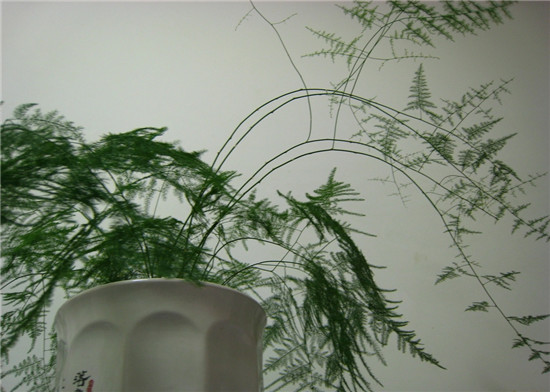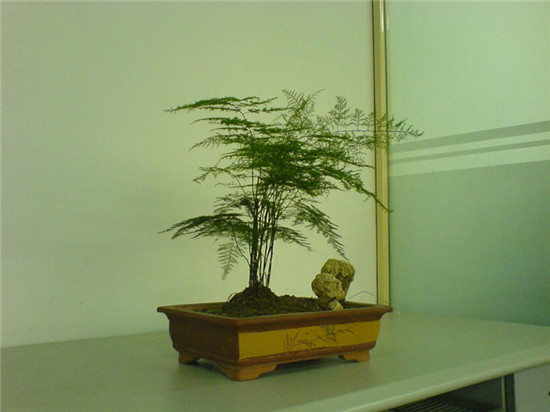Culture methods of asparagus Culture skills of asparagus
Asparagus, also known as Phyllostachys pubescens, is a perennial evergreen vine in Liliaceae. Next, let's take a look at the breeding skills of asparagus.

Asparagus is a negative plant, should not be placed in a place with too strong light, otherwise it is easy to cause branches and leaves withered and yellow. Watering should be appropriate, keep the basin soil wet and dry, generally watering to make the topsoil moist, dry season should be more to spray water to the leaf. Asparagus likes fertilizer, which is mixed with water and fully mature thin liquid fertilizer or milk residue dominated by nitrogen and potassium every 10-15 days. Asparagus grows fast and should be thinned too weak, too dense and old branches and withered stems at any time, which is conducive to ventilation and maintain a low posture. Asparagus can also be planted with bamboo tube, its water permeability, water storage are good, there is no need to drill holes at the bottom of the basin.
Growth habits: asparagus is not cold-resistant, not resistant to drought, like warmth, semi-shady environment, avoid frost. Asparagus has strict requirements for basin soil, which is loose, fertile, good drainage and good air permeability, and the basin soil had better be neutral. Rotten leaf soil, sand and mature fertilizer can be used. Asparagus is not cold-resistant and afraid of heat, and the suitable temperature for growth is between 15-25 ℃. That is, it can not stand direct light, but also can not stay in the shade for too long. Watering should not be too much, grasp the principle of watering dry and wet. Fertilizer can be used once a month to meet the growth needs. Raw asparagus in 2012 has the most ornamental value. Three-year-old asparagus begins to grow branches, and a bracket should be set up for it to climb. If you do not want to set up a bracket, you can also cut off the climbing branches to the root. Asparagus is not resistant to cold, and the overwintering temperature is 10 ℃.

Main points of cultivation: seedling raising is generally carried out from May to October. Before sowing, the seeds are soaked in warm water for 10-20 hours. After soaking, the seeds are mixed with plant ash. The seeds are covered with soil for about 1 cm. The seeds germinate and emerge in 15-25 days under shading conditions. The seedlings were planted in a small basin after two separate seedlings. Tolerance to semi-overcast, like a well-ventilated environment, lax requirements on the soil, less fertilization, less watering, so as to maintain the upright and short shape as far as possible.
Culture methods of asparagus
1. Potted soil: fertile sandy loam should be used to cultivate asparagus, which should be warm and humid, rich in rotten branches and good drainage. Generally, it can be prepared in the proportion of 4 parts of garden soil, 2 parts of rotten leaf soil, 2 parts of compost soil and 1 part of sand. And to change the soil regularly to add fertilizer. If excessive fertilization causes "watering roots", it is necessary to pour the pot to remove the fertilizer, irrigate the soil with clean water, and then put it into the new soil for breeding.

2. Watering: watering is the key point of asparagus cultivation and culture. too much watering and too wet basin soil can easily cause root rot, and too little watering will lead to scorched and yellowed leaf tips. Therefore, in the process of watering, it depends on the weather, growth and the dry and wet condition of the basin soil, so that if it is not dry, it will be watered thoroughly. When the weather is hot and dry, water spraying can be used to humidify and cool the leaves, but less watering is needed in winter.
3. Fertilization: asparagus is not good at fertilizer, but it can not be short of fertilizer. Limited by potted soil, asparagus culture must replenish nutrients in time to meet the growth requirements. In the process of fertilizing asparagus, it is necessary to apply more times and less amount, and do not apply thick fertilizer, otherwise it will cause leaf yellowing. Generally, you can choose to apply rotten thin liquid fertilizer once a month, and after the plant grows and finalizes, you can properly control and reduce fertilization.

4. Lighting: asparagus culture can not be exposed to the hot sun, hot season, should be placed in a cool and ventilated place. At the same time, asparagus flowering is not only afraid of wind, but also afraid of rain, should pay attention to good ventilation, good weather can be properly placed outside to receive sunlight. The temperature of potted asparagus in winter should be kept above 5 ℃ to avoid freezing.
5. Display: asparagus is mostly used for indoor desk decoration. Because asparagus is afraid of smoke and dust, if toxic gases are encountered, the branches and leaves are easy to yellow. therefore, asparagus should be placed in a clean and well-ventilated environment.
The above is the whole content of the culture methods and techniques of asparagus that I have summarized for you. I hope this article can help you. Please continue to follow us.
Related
- Wuhan Hospital Iron Tree Blooming Result Was Instantly Frightened by the Gardener Master
- Which variety of camellia is the most fragrant and best? Which one do you like best?
- What is the small blue coat, the breeding methods and matters needing attention of the succulent plant
- Dormancy time and maintenance management of succulent plants during dormancy
- Minas succulent how to raise, Minas succulent plant pictures
- What are the varieties of winter succulent plants
- How to raise succulent plants in twelve rolls? let's take a look at some experience of breeding twelve rolls.
- Attention should be paid to water control for succulent plants during dormant period (winter and summer)
- Watering experience of twelve rolls of succulent plants
- Techniques for fertilizing succulent plants. An article will let you know how to fertilize succulent plants.



